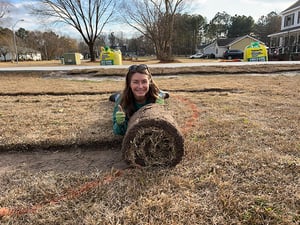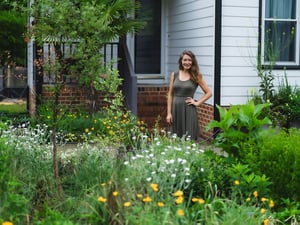Welcome to the third installment about the creating of my new native plant garden at the Carolina Garden House.
In this blog, we dive into the world of native grasses, sedges, and flowering perennials—nature's ground-level maestros that not only reduce weed pressure but also provide a haven for pollinators.
Join me as we explore three fascinating selections from each category, each with its own botanical allure.
First, it is important to recognize that through our early bed preparation using Soil³, we have created an ideal space for planting. By layering 4-6” of compost on top of the bare, native ground we have set the stage for success, especially with the herbaceous layer whose roots will utilize that the Soil³ the most.
If you missed the first part of the story, you can read it here Part 1: Breaking Ground & Soil Prep.
Native Grasses
Native ornamental grasses add a showy touch to any garden, and my current favorite is Panicum virgatum ‘Purple Tears.’ Discovered by the legendary Piet Oudolf in Hummelo, Netherlands, this switchgrass boasts splendid purple seed heads that stand tall at 4 feet. With a narrow, upright habit and the resilience of other Switchgrass cultivars, it's a low-maintenance stunner.
And let's not forget the iconic "muhly grass" or Muhlenbergia. The native pink muhly grass is a dream: long-lived, resistant to pests and deer grazing, and a showstopper with its pink flowers in the fall.
Pair it with 'White Cloud' muhly grass for a dynamic duo that captures attention.

In this video, learn more about the grasses we planted:
Native Sedges
Sedges are a grass-like plant botanically known as Carex. These plants are a horticulturist's dream due to their low maintenance.
Take, for instance, Carex cherokeensis, or Cherokee sedge, a Southeast native that thrives in various conditions, from full sun to deep shade. Its arching, lush green foliage and wheat-like seed spikes in spring make it a well-behaved beauty.
Another gem is the lurid sedge, Carex lurida, with bright yellow-green foliage cascading in an attractive clump, perfect for my wet, sandy soil.
And then there's Carex muskingumensis, the palm sedge, with its brilliant green leaves forming a pinwheel pattern, bringing architectural interest to shaded spots.
Remember the old rhyme, “sedges have edges, rushes are round, grasses have nodes all the way to the ground” and you will be able to distinguish between the many “grass-like” plants that you see!
This bed features native perennials with an understory of lurid sedge.

Here is a video showcasing the native Carex that we planted:
Native Flowering Perennials
Flowering perennials steal the show with their diversity, bloom times, and pollinator allure.
My favorites are the coneflowers (Echinacea), powerhouses for pollinators and goldfinch-friendly seed producers. The Sombrero Series, reaching only 20 inches in height, and the hybrid 'Pretty Parasols,' towering at 36-40 inches, offer a spectrum of colors to brighten up any garden.
While Echinacea purpurea, the "purple coneflower," takes the spotlight, let's not overlook other native species like E. laevigata and E. pallida. These beauties bring both aesthetics and low-maintenance ease to the garden.
Purple coneflower is the same Echinacea from herbal traditions.

And what's a garden without phlox? Woodland phlox (Phlox divaricata) is a charming, low-growing spring bloomer with a light fragrance. Moss phlox (Phlox subulata) is a resilient evergreen groundcover that defies tough conditions, while traditional garden phlox (P. paniculata) offers a global favorite with cultivars like 'Bright Eyes' and the 2024 Perennial Plant of the year 'Jeana' that pollinators adore.
'Bright Eyes' garden phlox with tiger swallowtail butterflies.

Lastly, let's talk about the unsung hero, mountain mint (Pycnanthemum). A capable spreader, but oh, the benefits! Planted strategically, it outcompetes weeds without the need for mulch, and it's a delightful treat for pollinators. With species like P. muticum and P. tenuifolium native to the mountains and piedmont of North Carolina, these perennials are a must for a pollinator-friendly, low-maintenance garden.
Mountain mint attracts copious pollinators and is a dense spreading plant. Shown here is P. tenuifolium.

Get inspired by all the perennials we installed in this video:
For your enjoyment, here is a playlist about my new native plant garden, as captured through my YouTube channel:

So, fellow plant enthusiasts, let's embrace the ecological wonders of native grasses, sedges, and flowering perennials. May your gardens be lush, vibrant, and a haven for the buzzing and fluttering creatures that bring joy to our horticultural endeavors!
Brie the Plant Lady
All photos & videos by Brie Arthur.



Did this help you out? Have any questions for clarity? Leave a comment below!